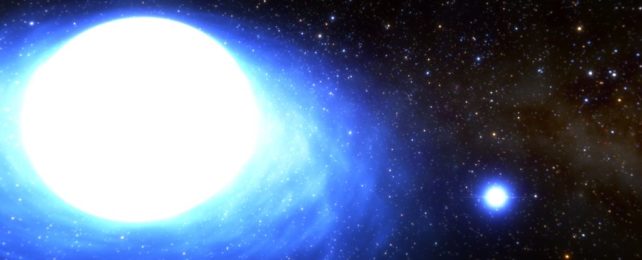For the first time, astronomers have positively identified a binary system that is destined to one day end up as a kilonova – the explosive result of a neutron star collision.
And, ironically, the key ingredient to this eventual fate is a pair of failed, fizzled supernovae. This phenomenon is thought to be so rare that there are only an estimated 10 such binary systems in the entire Milky Way. A closer study of this system should help scientists understand how these insane events evolve.
"For quite some time, astronomers speculated about the exact conditions that could eventually lead to a kilonova," says astronomer André-Nicolas Chené of NOIRLab.
"These new results demonstrate that, in at least some cases, two sibling neutron stars can merge when one of them was created without a classical supernova explosion."
Neutron star collisions are rare, but they play an important role in seeding the Universe with heavy elements such as gold, platinum, and uranium. These elements can't be created inside stellar cores; the energy required for the stellar nucleosynthesis of elements heavier than iron is greater than the energy this nucleosynthesis produces, resulting in a messy end for the star.
Instead, these elements are formed in energetic events, such as kilonovae: we have evidence of this from GW170817, the history-making neutron star collision observed by telescopes around the world. But these events are rare and, therefore, pretty mysterious. We've only seen a scant few neutron star mergers, and never before found a system destined to become one.
Enter a binary system called CPD-29 2176, consisting of a neutron star and a type of massive blue star called a Be star, located around 11,400 light-years from Earth. Be stars have features in their light that indicate the presence of material around them in the form of a disk.
They often also appear in binary systems with neutron stars, emitting X-rays as the neutron star passes through the disk surrounding the Be star.
When a bright X-ray flash was observed from the same part of the sky as the Be star in CPD-29 2176, astronomers Noel Richardson and Clarissa Pavao of Embry-Riddle Aeronautical University took a closer look, ultimately identifying a portion of light not emitted by the Be star. That was the neutron star.
They were also able to calculate the orbit of the binary. And this is where things got interesting. Because that orbit was unusually circular, as opposed to the more elliptical orbits usually seen in such binaries.
This was the smoking gun that led the researchers to conclude that the neutron star was born in a "dud" supernova – also known as an ultra-stripped supernova.
Usually, when a massive star goes supernova, it blasts off its outer material in a spectacular explosion, while the remaining core collapses down into a neutron star – an ultradense object up to about 2.4 times the mass of the Sun, packed into a sphere just 20 kilometers (12 miles) across.
In an ultra-stripped supernova, there's not enough outer material left to be exploded out into space. Instead, the core collapses with little fanfare. This seems to have been the case with CPD-29 2176.
"The star was so depleted that the explosion didn't even have enough energy to kick the orbit into the more typical elliptical shape seen in similar binaries," Richardson says.
So where did all that material go? As the neutron star reached the end of its life, it became puffy, putting its outer envelope within the gravitational reach of the Be star, which slurped it right up. By the time the star collapsed into a neutron star, it had been stripped right down, depriving it of the material that would have otherwise generated supernova fireworks.
Eventually, the Be star will also end its life as a neutron star, resulting in a neutron star binary in the decaying orbit that will one day produce a neutron star collision, the two merging to produce either a bigger neutron star, or a black hole.
"The current neutron star would have to form without ejecting its companion from the system. An ultra-stripped supernova is the best explanation for why these companion stars are in such a tight orbit," Richardson says.
"To one day create a kilonova, the other star would also need to explode as an ultra-stripped supernova so the two neutron stars could eventually collide and merge."
That day is a long way off, however. The Be star still has at least a million years left before its inevitable transformation. And the slow inspiral to the eventual merger could take millions more. But, with the identification of CPD-29 2176, astronomers have a new piece of the puzzle, and one that might help identify other such systems among the billions of stars in the Milky Way.
"This system reveals that some neutron stars are formed with only a small supernova kick," Richardson says.
"As we understand the growing population of systems like CPD-29 2176 we will gain insight into how calm some stellar deaths may be and if these stars can die without traditional supernovae."
The research has been published in Nature.
